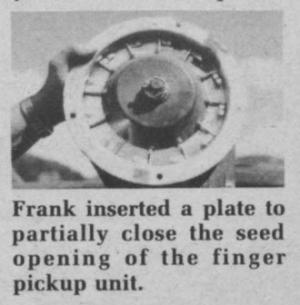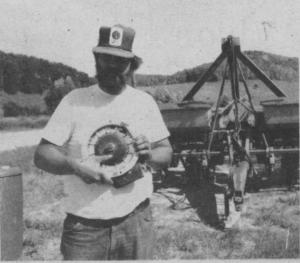Max-Emerge Overplants On Slopes
"I'd like to hear from other farmer-owners who have experienced a similar problem," says Wisconsin farmer David Frank, of Mondovi, who is unhappy with Deere and Company for "refusing to do anything about the inability of the 7000 series Max-Emerge to accurately plant corn on hillsides. Deere sold me this planter knowing I would be using it on hillsides, and knowing all along ù but not telling me ù that it overplants corn up to 100% or more on hillsides. I had to find out about the problem the hard way - on my own. And, now that I've pinpointed the problem, Deere refuses to do anything about it," Frank told FARM SHOW.
He says he didn't discover the "hillside problem" until three years ago when it was detected by the new Deere Compute Trak monitor he purchased for his planter. "It showed the planter was dropping more than 40,000 kernels per acre on slopes, which was about double the population I adjusted for and had assumed all along that I was getting. I alerted Deere officials as soon as I identified the problem but they told me they've had very few complaints, and that it isn't a common problem. Our local Deere dealer has done all he can. Deere did send out a factory rep but he was no help. He suggested I install a special seed hopper and install plates. Why did they sell me a plateless planter in the first place if I have to equip it with plates to make it plant accurately?"
Meanwhile, Frank has gone ahead with several of his own design changes in hopes of correcting or at least minimizing the "hillside problem" with his 4-row Max-Emerge, which is equipped with no-till coulters, hold-down springs and cast iron closing wheels. "On hill-sides with the left side of the planter lower than the right, seed rides high and siphons up into the finger mechanism. Centrifugal force propels extra kernels into the opening as each finger passes by. I inserted a special plate to partially close the opening, which has helped but extra kernels still sneak through. And, if you close the opening too much, you underplant," explains Frank.
He notes that, in addition to size of this opening, the degree of overplanting is affected by seed size, how full the hoppers are, travel speed and the degree of hillside slope. "My quarrel with Deere is that they knowingly sold me a planter they've known all along won't plant accurately on hillsides. They surely should be able to supply a planter that will accurately plant on slopes to which their hillside combine will level. There are factory recall programs for cars. I feel there should have been one on the Max-Emerge to correct this problem with planting accuracy on hillsides. If other owners have experienced a similar problem, I'd like to hear from them," says Frank.
Contact: David Frank, Rt. 3, Mondovi, Wis. 54755 (ph 715 946-3576).
FARM SHOW contacted Deere officials, asking the question: To what extent has overplanting on hillsides been a problem with Max-Emerge corn planters? We hadn't yet received their answer as this issue went to press. Meanwhile, we did obtain an evaluation report (No. 357) on the Deere 7000 Max-Emerge from the Prairie Agricultural Machinery Institute, headquarterd at P.O. Box 1900, Humboldt, Sask. S0K 2A0 (ph 306 682-2555). They note as follows: "While operating at 5 mph on 11 degree slopes, an increase in the frequency of doubles caused a decrease in the Quality of Feed Index by 2 to 3%. At 7 mph, the effect of the slope was greater, especially when seed was sloped towards the finger pickup unit. This condition caused a large increase in the frequency of doubles, thus dropping the Quality of Feed Index 10 to 20%. Flat seed was affected more than round seed."

Click here to download page story appeared in.
Click here to read entire issue
Max-Emerge Overplants On Slopes PLANTING EQUIPMENT Planters 8-6-5 "I'd like to hear from other farmer-owners who have experienced a similar problem," says Wisconsin farmer David Frank, of Mondovi, who is unhappy with Deere and Company for "refusing to do anything about the inability of the 7000 series Max-Emerge to accurately plant corn on hillsides. Deere sold me this planter knowing I would be using it on hillsides, and knowing all along ù but not telling me ù that it overplants corn up to 100% or more on hillsides. I had to find out about the problem the hard way ù on my own. And, now that I've pinpointed the problem, Deere refuses to do anything about it," Frank told FARM SHOW.
He says he didn't discover the "hillside problem" until three years ago when it was detected by the new Deere Compute Trak monitor he purchased for his planter. "It showed the planter was dropping more than 40,000 kernels per acre on slopes, which was about double the population I adjusted for and had assumed all along that I was getting. I alerted Deere officials as soon as I identified the problem but they told me they've had very few complaints, and that it isn't a common problem. Our local Deere dealer has done all he can. Deere did send out a factory rep but he was no help. He suggested I install a special seed hopper and install plates. Why did they sell me a plateless planter in the first place if I have to equip it with plates to make it plant accurately?"
Meanwhile, Frank has gone ahead with several of his own design changes in hopes of correcting or at least minimizing the "hillside problem" with his 4-row Max-Emerge, which is equipped with no-till coulters, hold-down springs and cast iron closing wheels. "On hill-sides with the left side of the planter lower than the right, seed rides high and siphons up into the finger mechanism. Centrifugal force propels extra kernels into the opening as each finger passes by. I inserted a special plate to partially close the opening, which has helped but extra kernels still sneak through. And, if you close the opening too much, you underplant," explains Frank.
He notes that, in addition to size of this opening, the degree of overplanting is affected by seed size, how full the hoppers are, travel speed and the degree of hillside slope. "My quarrel with Deere is that they knowingly sold me a planter they've known all along won't plant accurately on hillsides. They surely should be able to supply a planter that will accurately plant on slopes to which their hillside combine will level. There are factory recall programs for cars. I feel there should have been one on the Max-Emerge to correct this problem with planting accuracy on hillsides. If other owners have experienced a similar problem, I'd like to hear from them," says Frank.
Contact: David Frank, Rt. 3, Mondovi, Wis. 54755 (ph 715 946-3576).
FARM SHOW contacted Deere officials, asking the question: To what extent has overplanting on hillsides been a problem with Max-Emerge corn planters? We hadn't yet received their answer as this issue went to press. Meanwhile, we did obtain an evaluation report (No. 357) on the Deere 7000 Max-Emerge from the Prairie Agricultural Machinery Institute, headquarterd at P.O. Box 1900, Humboldt, Sask. SOK 2AO (ph 306 682-2555). They note as follows: "While operating at 5 mph on 11 degree slopes, an increase in the frequency of doubles caused a decrease in the Quality of Feed Index by 2 to 3%. At 7 mph, the effect of the slope was greater, especially when seed was sloped towards the finger pickup unit. This condition caused a large increase in the frequency of doubles, thus dropping the Quality of Feed Index 10 to 20%. Flat seed was affected more than round seed."
To read the rest of this story, download this issue below or click
here to register with your account number.








